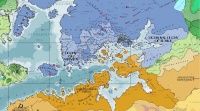New Kalikán Empire

The New Kalikán Empire (aka Thracian Empire), 2537 to 2576, arose from the conquests of Khabur (2529 to 2536). The great valleys of the High Shadevan Plateau had been united in the late twenty fifth to early twenty sixth centuries under the rule of the powerfully restored Kingship of Thrace. By 2503, the regions of the High Shadevan Plateau had been brought together in the United Kingdom of Thrace, Gantvia, Jamenth, Shaddago, and Hamalan. At this time, Dakkal was a direct tributary of Thrace. The Kingdom was often called the United Kingdom of Greater Thrace.
Improvements in skycraft technology, especially the Kharrhu-Visha (2510), enabled the more prolific manufacture of lighter, more mobile, and longer ranged vessels of the sky. Additionally, the invention and use of the aerobarge (2517) enabled the transportation of troops and materiel in the foothills of the Jaggudorns and eventually elsewhere in the Thracian Empire. Aerobarge troopships could bring dwarvenfire-armed combatants swiftly to battles and to the battlefront in the High Shadevan Plateau and also throughout Pytharnia which was the core of the extra-Jaggudornian territory of the Thracian Empire. The development and use of the obusier in Thrace gave the Thracians a military advantage in battle before the competition of antiphlogistics in the following century.
The term 'New Kalikán Empire' was popularly employed at home and abroad as a resurgence in the ethnic nationalism of the Kalikán people of Thrace. It is the last powerful period of the Kalikán up to the present time. The Kalikán allied with the Geddamin and created the basis for a powerful animus against them in the hearts and minds of other human nations, leading to the Reduction of Thrace.
Like Vankkagomir and Khabur before, the true rulers of the Kalikán were the military and the king served only as a religious and cultural figurehead who was held in great reverence. There are numerous aristocratic families in Pytharnia and in east Asdauria that can trace their heritage back to Thracian nobility as their ancestors were installed into positions of power during the 26th century.
In addition to defeat and occupation, Thrace suffered civil war that nearly had the royal family executed and saw the execution and exile of several military rulers.
The King-Emperor, King of Thrace, Emperor of the Kalikán, was the figurehead of the Thracian Empire. In some periods of the twenty sixth century, he was beholden to a military junta, but became independent around the middle of the century.
Chronology of the New Kalikán Empire
- 2487 to 2503, Formation of the United Kingdom of Greater Thrace
- 2494: birth of Khabur, future military ruler of Thrace
- Vankkagomir, de facto military ruler 2507 to 2514, monarchy reduce to figurehead, conquest of Jaggudorns, western Asdauria, Vankkagomirian Empire, 2509 to 2521. Vankkagomir employs new skycraft technology,
- 2507, Battle of Giaddirs (2507) Thracian skyforces under Vankkagomir seize Aurice from the Medibgóëse forces. Death of Medibgóëse Prince-Governor Llewchobrag in battle.
- 2509, Battle of Gorlip, Thracian forces under Vakkagomir defeat the forces of the Medibgóëse Empire, end of Telsenahrian War, 2506 to 2509
- 2509, Vankkagomir establishes triumvirate with Kamunthára and Basgúndin to rule Thrace and the Thracian Empire.
- ca 2510: development of the Kharrhu-Visha, first fully metal-framed skycraft, offers greater speed and range, eliminates dependence upon trees.
- 2513, Vankkagomir and Basgúndin join together and betray Kamunthára
- 2514, Kamunthára slain in battle
- 2517: invention of the Aerobarge, facilitates movement of troops and materiel.
- ca 2520: Thracians develop the obusier, an indirect fire dwarvenfire cannon, from the damarissica. The obusier is subsequently used in the First Battle of Jardonia 2521.
- 2521, First Battle of Jardonia (2521), Basgúndin fights against Vankkagomir who is defeated and sent into exile to Omeddim.
- 2522 to 2529: Peace of Sky (2522 to 2529)
- 2523, Väduk Vädudzund ascends to the throne of Thrace
- 2527 to 2530, Second Geddamin War, does not directly provoke the Thracian Empire.
- 2529 to 2539, Conquests of Khabur
- 2531 Conquest of Medibgö and Magdala
- 2534 to 2538 Khabur makes himself pre-eminent as commander in the conquest of southern Pytharnia, Dúrandwor, Gonfaloy, Ambrasia, Asbardy
- 2537, Khabur created First Commander of Thrace (Khamilúk Epavi); King Väduk receives title of King-Emperor of Thrace
- 2538, Khabur titled First Lord of the Sky
- 2539, The rule of the First Lord of Sky is dissolved by intrigues of the royal court and loyal nobles, Khabur sent into exile.
- 2546, Ädaz Vädukund ascends to the throne of Thrace
- 2550, Kalikán-Ephysgæes Pact
- 2550, outbreak of Third Geddamin War, 2550 to 2556
- 2552, Khabur dies in exile, probably assassinated by Thracian agents
- 2568, outbreak of the Great Sky War, 2568 to 2575
- 2568, outbreak of the Fourth Geddamin War
- 2570, renegotiation of Kalikán-Ephysgæes Pact
- 2573, Ondaz Ädazund ascends to the throne of Thrace
- 2573, Battle of Pytharnia fought over Trevirs
- 2574, Second Battle of Jardonia (2574), turning point of war
- 2574, Thracian Revolution (2574)
- 2575, Battle of Thrace
- 2575, Occupation of Thrace
- 2576, Treaty of Tauhad (2576), Empire dissolved and Thracian monarchy abolished
See Also
- Great Sky War (2568 to 2575)
- King-Emperor of Thrace
- Kalikán-Ephysgæe Pact (2570)
- List of the Rulers of Thrace
- Thracian Military and Aristocratic Ranks
- Reduction of Thrace
- Thracian Revolution (2574)
- Thrake
- Treaty of Tauhad (2576)
- United Kingdom of Greater Thrace
| This article is a stub. It requires further development by the creator. |